Container Garden-To-Go
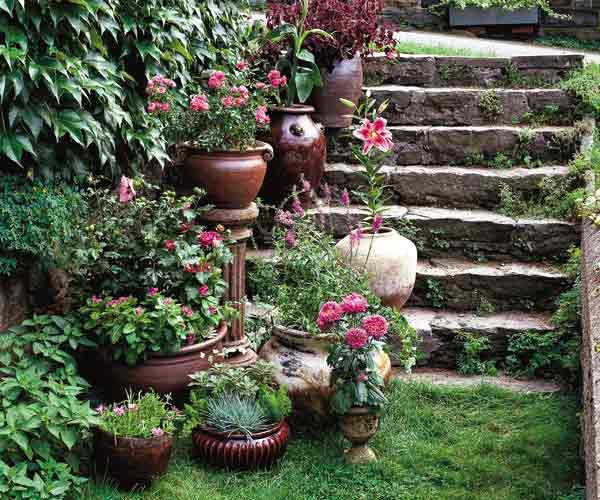
A potful of plants is the quickest way to extend your garden onto a porch, patio, or deck. Small trees and shrubs in planters can accentuate an entryway or steps—or even conceal the recycling bins. And containers are an easy way to add color and greenery where there’s simply no place to plant. “The trick,” says This Old House landscape contractor Roger Cook, “is finding the right combination of pots and plants to suit the situation.”
Shown: Clustered along a stone wall and stairway, clay and stone pots in earthy grays and browns provide a backdrop for a variety of pink-flowering greenery.
Choosing a Container
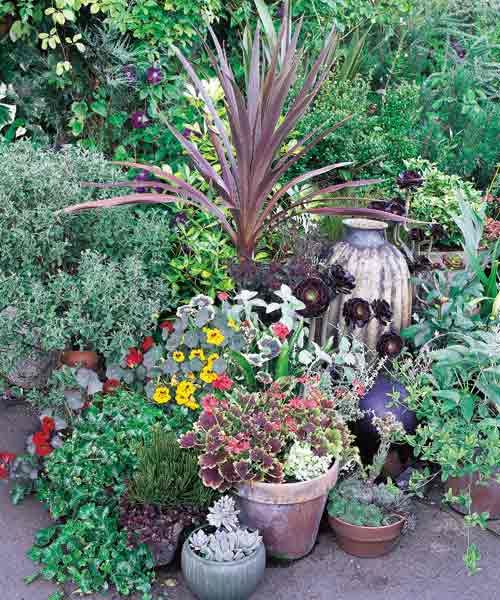
A good pot is not only decorative, it protects a plant’s roots from wind and heat and helps keep them moist, making containers a great way to extend your growing season.
Terra-cotta drains well and allows roots to breathe. Unfortunately, its natural porosity makes it dry out quickly in the summer and freeze—and crack—in the winter if left outside. “I love the look of terra-cotta,” says Roger, “but it can be high-maintenance.”
Glazed ceramic and cast-concrete pots are less finicky. These containers retain water longer than terra-cotta, endure freezing winter temperatures, and come in a wide variety of colors and textures. However, they are heavy, a factor to consider if you like to shuffle the garden around occasionally.
Box and half-barrel containers made from naturally rot-resistant redwood or cedar lend a nice rustic touch but are as cumbersome as concrete and not as durable.
Related: How to Place Pots
Shown: A container garden of sun-loving annuals and perennials yields a riot of color and texture. Red and yellow blossoms are set off by foliage that ranges from pale green to deep burgundy.
Impressive Faux Material Containers
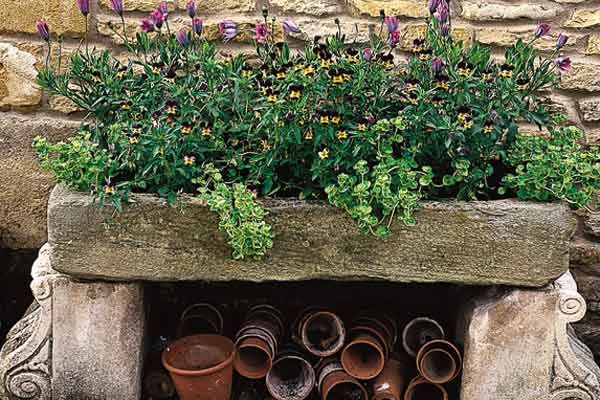
Faux stone and faux terra-cotta containers made from plastics and other man-made materials are a truly lightweight alternative, weighing only a few pounds. They’re also impervious to frost and are not porous. Roger concedes that these containers have gotten better-looking, but he points out that they’re not as tough as their natural counterparts. “Watch where you’re pointing your pruning shears or you might puncture them,” he says.
Related: Faux Stone Containers
Whatever the pot’s material, opt for one large container (14 inches or more in diameter) rather than several small ones if you can. Bigger pots stay moist longer and allow plants room to grow.
Shown: An old stone trough makes a distinctive container for a cottage-style combo of violas and loosestrife.
Combining Plants
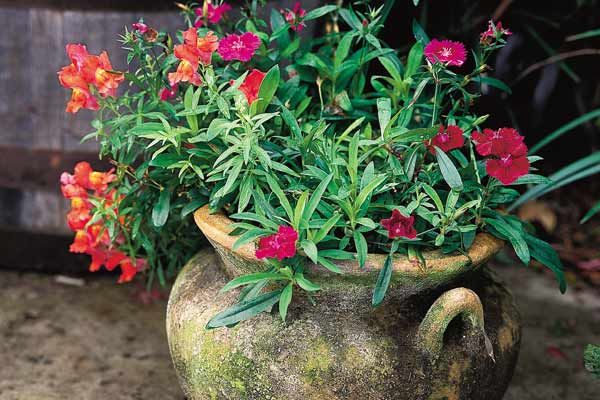
Consider each pot a mini garden, and choose the contents accordingly. “A single type of plant gets a little monotonous,” says Roger. “I like to mix lots of things together.” Not just colorful annuals, either. “I’ll work in perennials like a gold hosta or an ornamental grass,” he says. “Then, in the fall, I’ll remove it and plant it in the garden.”
How to design a pleasing arrangement in a pot? Place taller plants, like sword-leaved phormium, larger delphiniums, or even a small tree, in the center of the container. Fill in around the central elements with “fluffy” plants like scented geraniums, nemesia, and double impatiens. Along the edge of the pot, install trailers like hybrid vincas or lobelia, or trailing vines like sweet potato, which can cascade over the side.
Test-drive colors and combinations by mixing and matching plants right at the garden center in the early spring. “You’ll see what you like and don’t like that way,” says Roger. “It’s much easier to return things to the shelf before you’ve hauled them home.”
Shown: Snapdragons and dianthus spill over the edge of a weathered terra-cotta urn. below: An old stone trough makes a distinctive container for a cottage-style combo of violas and loosestrife.
Potting Particulars
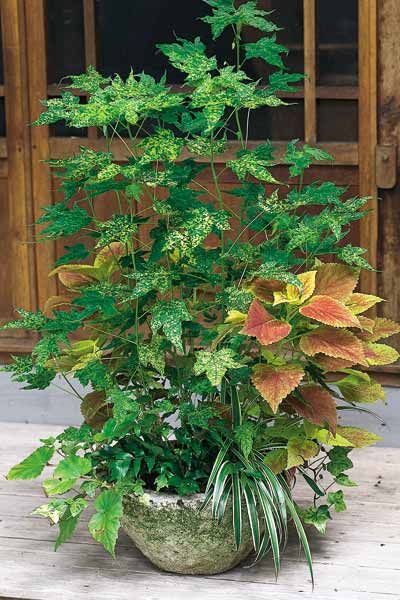
To ensure that plants receive the proper amount of food and water, you’ll need to layer the pot with a combination of soil and additives. Start by placing pottery shards over the container’s drainage holes, then add 2 to 3 inches of gravel. (If weight is a concern, use styrofoam “peanuts” instead.) This bottom layer allows water to drain away from roots so they won’t rot.
Next, mix 4 parts potting soil to 1 part sand or perlite, which enhances the soil’s drainage. Add in a slow-release fertilizer according to package directions. Then fill the container to within 2 inches of the top with this mixture. In extremely hot, dry areas, augment the bottom third of the mixture with a wetting agent like Soil Moist, which stores water, releasing it as necessary, and keeps the roots from overheating.
Once the plants are in place, top dress the soil with gravel, bark, or another mulch material. “I like to use green moss,” says Roger. “It’s attractive, natural, and helps keep in the moisture.”
Place the pot atop terra-cotta, brick, or plastic spacers to assist drainage and allow air to circulate beneath.
Shown: A porous hand-molded concrete pot holds a combination of coleus, flowering maple, spider plant, and holly fern.
Post-Planting Care
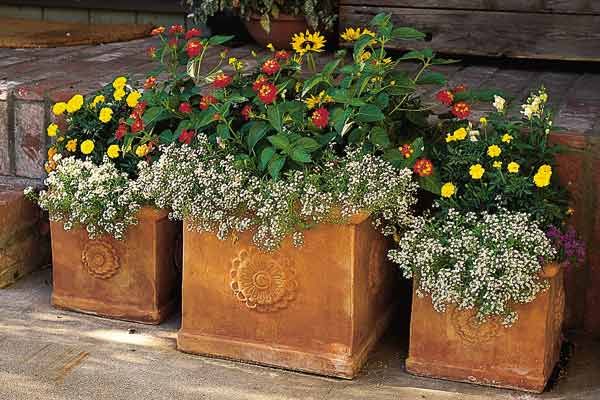
Above all, container gardens need consistent watering. Water slowly and thoroughly, until water drips from the pot’s drainage holes. If possible, place the container inside a larger pot or washtub and soak it. To slow the drying process, position containers out of the afternoon sun. In hot, dry conditions, pots may need watering twice a day.
After plants have settled in for two to three months, apply a liquid fertilizer weekly, as directed. “Too much fertilizer will fry a plant’s roots in a flash,” says Roger. “Almost as fast as forgetting to water them.”
Shown: This trio of terra-cotta boxes overflows with candytuft and marigolds.
Anatomy of a Container Garden
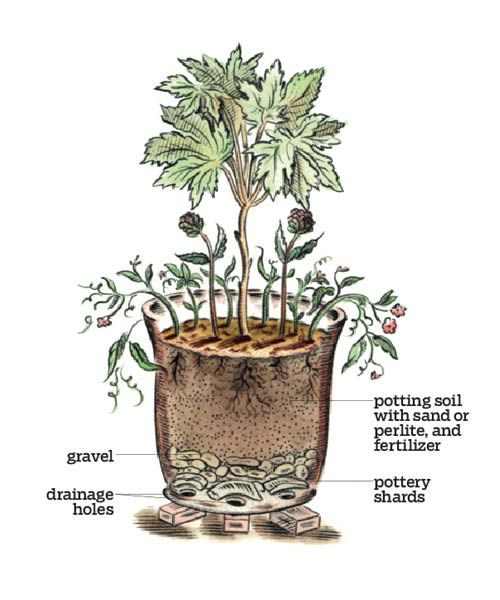
Container gardens need well-drained soil and regular fertilizing. Choose plants of varying heights, colors, and textures—tallest in the center, trailers along the outside edge—and space them 4 to 6 inches apart, leaving room to grow.
Related: Planter Fix: Drill a Drainage Hole
Winning Combinations: Sun-Loving English Cottage Mix
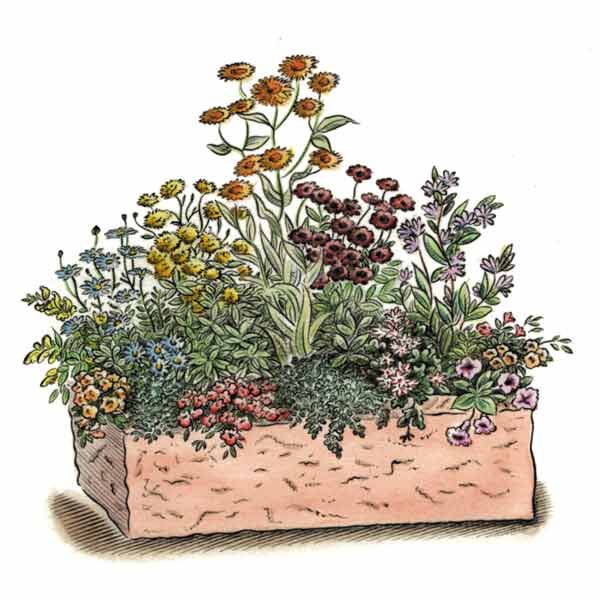
Water daily and deadhead regularly to encourage bloom. In hot climates, keep out of afternoon sun.
1 Blue marguerite
(Felicia amelloides)
1 Coreopsis
(C. grandiflora ‘Early Sunrise’)
1 Chocolate cosmos
(Cosmos atrosanguineus)
2 Diascia
(Diascia hybrid ‘Coral Belle’)
1 Ivy geranium
(Pelargonium peltatum ‘Candy Stripe’)
2 Million bells
(Calibrachoa ‘Terra Cotta’)
1 Petunia
(P. hybrida ‘Double Pink Veined’)
1 Scaevola
(S. aemula ‘Blue Wonder’)
3 Silver-edged thyme
(Thymus citriodorus ‘Argeneus’)
3 Snapdragons
(Antirrhinum majus ‘Sweet Lemon Blush’)
1 Strawflower
(Helichrysum bracteatum ‘Dargan Hill Monarch’)
Winning Combinations: Shade-Loving Mix
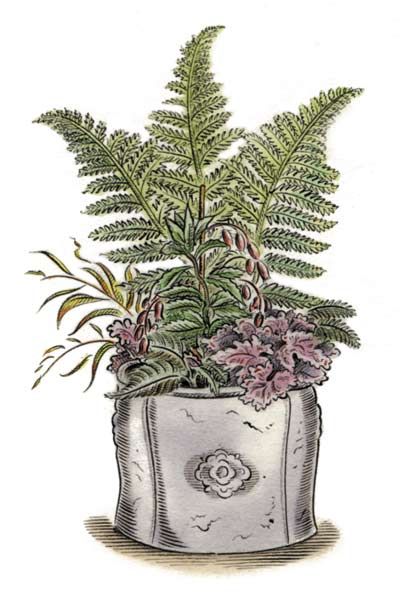
Fern should be 5-gallon size. Enrich the soil with an organic fertilizer. Keep moist and protected from wind.
3 Coral bells
(Heuchera ‘Amethyst Mist’)
1 Flowering maple
(Abutilon megapotamicum ‘Pink’)
1 Golden Hakone grass
(Hakonechloa macra ‘Aureola’)
2 Japanese painted fern
(Athyrium goeringianum ‘Pictum’)
1 Tasmanian tree fern
(Dicksonia antarctica)
Winning Combinations: Fragrant White Mix
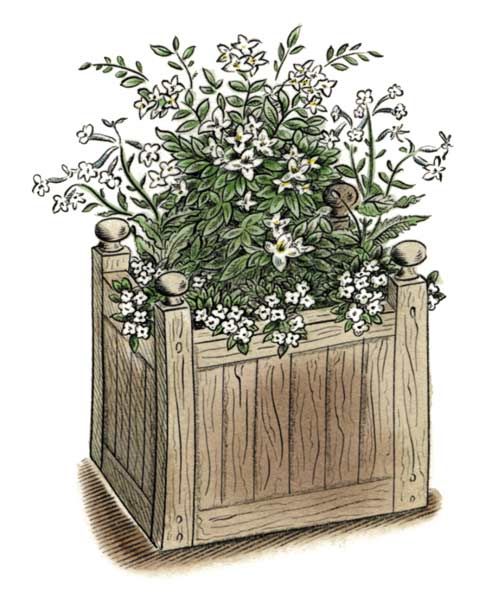
Add extra perlite to create well-drained soil. Protect from intense afternoon sun.
5 Alyssum
(Alyssum ‘Snow Crystal’)
1 Mock orange
(Philadelphus ‘Miniature Snowflake’)
3 Tobacco plants
(Nicotiana alata ‘White’)
Winning Combinations: Drought-Tolerant Mix
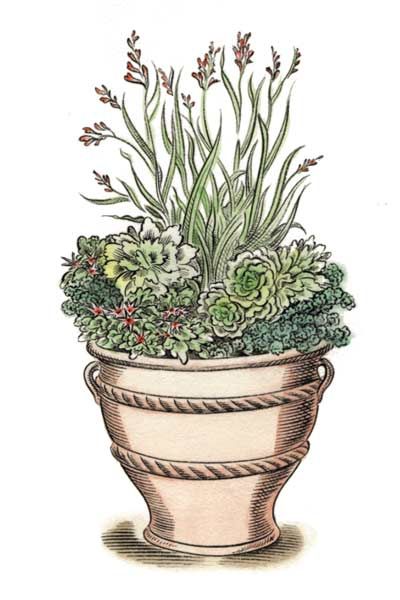
Add a handful of sand to the soil for extra drainage. Place in full sun.
3 Hens and chicks
(Echeveria secunda)
1 Kangaroo paw
(Anigzanthos ‘Bush gemseries “Bush Glow”‘)
3 Sedum spathulifolium
(‘Cape Blanco’)
2 Sedum spectabile
(‘Mini Joy’)
3 Sedum spurium
(‘Dragon’s Blood’)
